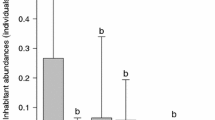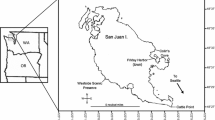Abstract
Mussels (Mytilus californianus, M. galloprovincialis) and other organisms sloughed from offshore oil platforms provide a food subsidy to benthic consumers and alter underlying soft bottom habitat by creating hard substrate. The removal of overlying platforms eliminates this food subsidy, but large shell mounds remain. The distribution, abundance, and population characteristics of mobile macroinvertebrates differed among shell mounds beneath existing offshore oil platforms, shell mounds at the former sites of offshore oil platforms, and soft bottom. Predatory and omnivorous echinoderm and mollusk species were more abundant and generally larger on shell mounds under platforms than on shell mounds without platforms. Omnivorous and deposit feeding echinoderms were the most abundant macroinvertebrate taxa sampled on mound-only sites. The brown rock crab (Cancer antennarius), known to have a strong preference for hard substrate, was significantly more abundant on shell mounds, with or without platforms, than adjacent soft bottom sites. Results suggest that the effects of platform removal differed among benthic species according to trophic level, degree of mobility, and substrate preference. Although the shell mound habitat persists after removal of platform structures, species abundance and the composition of the associated benthic community is altered by removal of the platform structure.







Similar content being viewed by others
References
Bascom W, Mearns AJ, Moore MD (1976) A biological survey of oil platforms in the Santa Barbara Channel. J Petroleum Tech 28:1280–1284
Bohnsack JA (1989) Are high densities of fishes at artificial reefs the result of habitat limitation or behavioral preference? Bull Mar Sci 44:631–645
Bustamante RM, Branch GM (1996) The dependence of intertidal consumers on kelp-derived organic matter on the west coast of South Africa. J Exp Mar Biol Ecol 196:1-28
Bustamante RH, Branch GM, Eekhout S (1995) Maintainance of an exceptional intertidal grazer biomass in South Africa: subsidy by subtidal kelps. Ecology 76:2314–2329
Carroll JC, Winn RN (1989) Species profiles: life histories and environmental requirements of coastal fishes and invertebrates (Pacific Southwest) Brown Rock Crab, Red Rock Crab, and Yellow Crab. In: US Army Corps of Engineers Report No. TR EL-82–4, U.S. Fish and Wildlife Service Biological Report 82 (11.117), Vicksburg, Miss.
Dahlhoff E, Menge BA (1996) Influence of phytoplankton concentration and wave exposure on the ecophysiology of Mytilus californianus. Ecology 144:97–107
Davis N, Van Blaricom GR, Dayton PK (1982) Man-made structures on marine sediments: effects on adjacent benthic communities. Mar Biol 70:295–303
Dugan JE, Hubbard DM, McCrary MD, Pierson MO (2003) The response of macrofauna communities and shorebirds to macrophyte wrack subsidies on exposed sandy beaches of Southern California. Estuarine Coastal Shelf Sci 58S:133–148
Gabbott PA (1976) Energy metabolism. In: Bayne BL (ed) Marine mussels: their ecology and physiology. Cambridge University Press, Cambridge, pp 293–355
Gabbott PA (1983) Developmental and seasonal metabolic activities in marine mollusks. In: Hochachka PW (ed) The Mollusca 2. Environmental biochemistry and physiology. Academic Press, New York, pp 165–217
Herrnkind WF, Butler MJ IV, Hunt JH (1997) Can artificial habitats that mimic natural structures enhance recruitment of Caribbean spiny lobster? Fisheries 22:24–27
Kohn AJ (1966) Food specialization in Conus in Hawaii and California. Ecology 47:1041–1043
Landenberger DE (1968) Studies on selective feeding in the Pacific starfish Pisaster in Southern California. Ecology 49:1062–1075
Link JS, Almeida FP (2002) Opportunistic feeding of longhorn sculpin (Myoxocephalus octodecemspinosus): are scallop fishery discards an important food subsidy for scavengers on Georges Bank? Fish Bull 100:381–385
Love MS, Schroeder DM, Nishimoto MM (2003) The ecological role of oil and gas production platforms and natural outcrops on fishes in southern and central California: a synthesis of information. OCS Study MMS 2003–032, U.S. Geological Survey, Biological Resources Division, Seattle, Washington 98104.
MEC Analytical Systems (2003) An assessment and physical characterization of shell mounds associated with outer continental shelf platforms located in the Santa Barbara Channel and Santa Maria Basin, California. MMS No. 1435–01–02-CT-85136, Final Report prepared for U. S. Minerals Management Service, Pacific OCS
Menge BA (1992) Community regulation: under what conditions are bottom-up factors important on rocky shores? Ecology 73:755–765
Morris RH, Abbott DP, Haderlie EC (1980) Intertidal invertebrates of California. Stanford University Press, Stanford, Calif.
Page HM, Hubbard DM (1987) Temporal and spatial patterns of growth in mussels Mytilus edulis on an offshore platform: relationships to water temperature and food availablity. J Exp Mar Biol Ecol 111:159–179
Page HM, Dugan JE, Dugan DS, Richards JB, Hubbard DM (1999) Effects of an offshore oil platform on the distribution and abundance of commercially important crab species. Mar Ecol Prog Ser 185:47–57
Paine RT (1974) Intertidal community structure studies on the relationship between a dominant competitor and its principle predator. Oecologia 15:93–120
Polis GA, Holt RD, Menge BA, Winemiller KO (1996) Time, space, and life history: influences on food webs. In: Polis GA, Winemiller KO (eds) Food webs: integration of patterns and dynamics. Chapman and Hall, New York, pp 435–460
Reilly PN (1987) Population studies of rock crab, Cancer antennarius, yellow crab, C. anthonyi, and Kellet’s whelk, Kelletia kelletia, in the vicinity of Little Cojo Bay, Santa Barbara County, California. Calif Fish Game 73:88–98
Rogers-Bennett L, Ono DS (2001) Sea cucumbers. In: WS Leet, CM Dewees, R Klingbeil, EJ Larson (eds) California’s living marine resources: a status report. California Department of Fish and Game, pp 1131–134
Rosenthal RJ (1971) Trophic interaction between the sea star Pisaster giganteus and the gastropod Kelletia kelletii. Fish Bull 69:669–679
Sanford E, Menge BA (2001) Spatial and temporal variation in barnacle growth in a coastal upwelling system. Mar Ecol Prog Ser 209:143–157
Shriver AC, Carmichael RH, Valiela I (2002) Growth, condition, reproductive potential, and mortality of bay scallops, Astropecten irradians, in response to eutrophic-driven changes in food resources. J Exp Mar Biol Ecol 279:21–40
Simpson RA (1977) The biology of two offshore oil platforms. Institute of Marine Research, University of California, San Diego, IMR Reference 76–13
Winn RN (1985) Comparitive ecology of three Cancrid crab species (Cancer anthonyi, C. antennarius and C. productus) in marine subtidal habitats in southern California. PhD dissertation, University of Southern California, Los Angeles
Wit LA de (2001) Shell mounds environmental review. Final technical report, vols 1 and 2. Bid Log No. RFP99–05, prepared for California State Lands Commission and California Coastal Commission
Wolfson A, Van Blaricom G, Davis N, Lewbel GS (1979) The marine life of an offshore oil platform. Mar Ecol Prog Ser 1:81–89
Yingst JY (1974) The utilization of organic detritus and associated microorganisms by Parastichopus parvimensis, a benthic deposit-feeding holothurian. PhD dissertation, University of Southern California, Los Angeles
Zar J (1999) Biostatistical analysis. Pearson Education (Singapore), Delhi, India
Acknowledgements
We thank J. Bram, C. Culver, E. Hessell, B. Mardian, C. Reger, A. Willis, and B. Wolcott for assistance in the field. B. Evans kindly provided shell mound photographs. J. Childress, R. Schmitt, B. Kinlan and A. Bull provided helpful comments on the manuscript. This research was made possible by a grant to H.M.P. and J.E.D. from the Minerals Management Service, US Department of the Interior, under MMS agreement No. 1435–01–00-CA-31063 and the Coastal Marine Institute, University of California, Santa Barbara. The views and conclusions contained in this document are those of the authors and should not be interpreted as necessarily representing the official policies either expressed or implied of the U.S. government.
Author information
Authors and Affiliations
Corresponding author
Additional information
Communicated by P.W. Sammarco, Chauvin
Rights and permissions
About this article
Cite this article
Bomkamp, R.E., Page, H.M. & Dugan, J.E. Role of food subsidies and habitat structure in influencing benthic communities of shell mounds at sites of existing and former offshore oil platforms. Marine Biology 146, 201–211 (2004). https://doi.org/10.1007/s00227-004-1413-8
Received:
Accepted:
Published:
Issue Date:
DOI: https://doi.org/10.1007/s00227-004-1413-8




